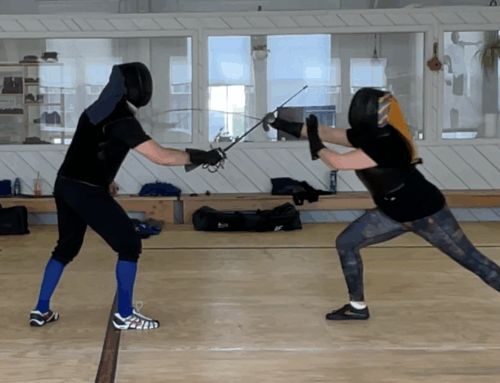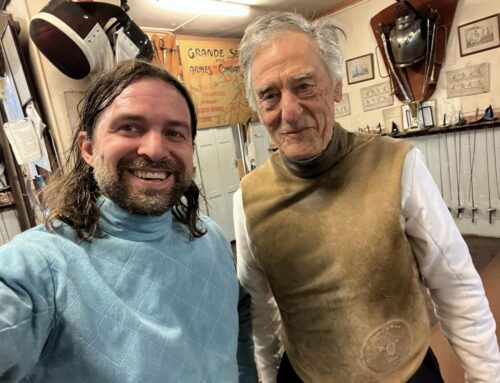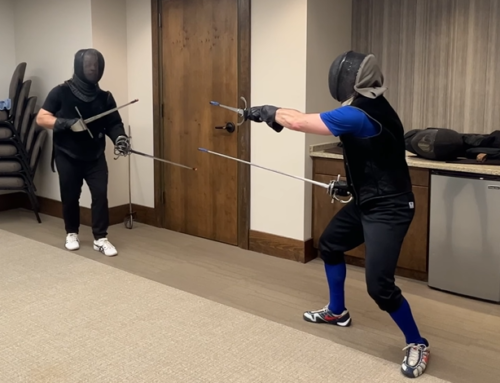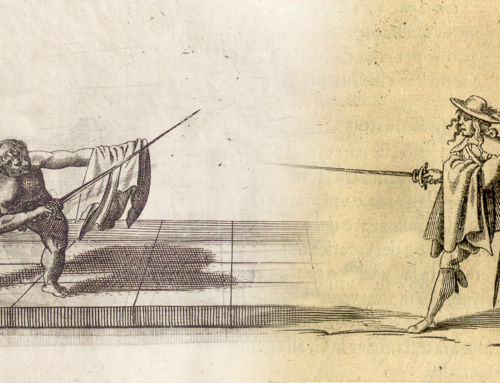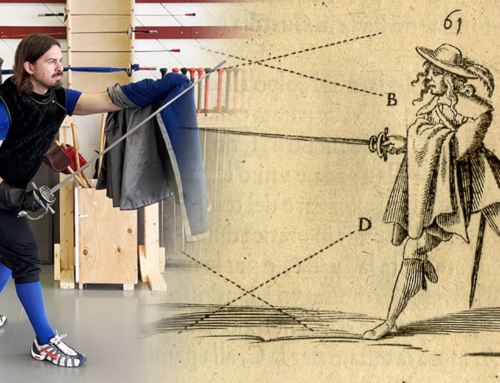Today we’ll be looking at the plays in Plate 10 of La Scherma by Francesco Ferdiando Alfieri. You can snag a copy over on Amazon if you want to follow along.
You can also find the rest of my Alfieri & other historical rapier research over in the Historical Fencing section.
In this chapter, Alfieri talks about the dangers of throwing a cut while in measure and how a fencer can respond to an opponent who’s attempting to throw a cut.
The Play
In this plate we have Gentleman 18 and Gentleman 19.
Play #1. Gentleman 19 approaches on the outside line in seconda while Gentleman 18 is on guard in guardia mista. Gentleman 19 “disorders” Gentleman 18’s sword with a strike in seconda from tutta coperta…
[Tutta Coperta means totally covered and describes a guard in which your opponent has no direct line of attack, covering both high and low line attacks. Alfieri mentions tutta coperta two more times in later chapters regarding fighting sword/dagger and sword/cloak. He doesn’t describe what it means (or looks like) in this instance.
In this instance, I’m taking this to mean a close guard, similar to the other chapters where he mentions it, but without the off-hand weapon. This would be bringing the off-hand across the body and angling it so the hand is near the sword hand/hilt. This makes a cavazione much more difficult because the off hand is blocking the easiest path on the low line. ]
…In this same tempo Gentleman 19 raises his arm in terza to deliver a cut. Gentleman 18 has pulled back his body and sword, and has somewhat broken measure (i.e., a retreat) and then lunges “at great speed” from a firm foot (lunge), striking Gentleman 18 in the face in quarta.
It’s a messy scenario and is written more messily in the translation. However, here’s how I would script this first play out in a little easier to follow format:
- Gentleman 18 stands in guardia mista and Gentleman 19 in seconda.
- Gentleman 19 approaches on the outside line and throws an attack in seconda from tutta coperta.
- Gentleman 18 cannot counter attack because of tutta coperta, but is able to parry the attack and retreat enough out of harms ways.
- Gentleman 19, missing his original attack but in the same tempo, raises his arm into terza to deliver a cut.
- Gentleman 18, noticing Gentleman 19’s blade is offline, lunges in quarta and striking Gentleman 19 in the face.
Play #2.
Alfieri also explains that the same end result can happen if Gentleman 19, in a fury, raises his sword to deliver a mandritto (R to L cut) riverso (L to R cut) to Gentleman 18’s head.
Alfieri notes that Gentleman 18 should be bold as he moves to wound in this tempo and not fear Gentleman 19’s sword.
Play 3. While Alfieri mentions that the thrust is “better and more lethal” than the cut, he says we shouldn’t overlook potential responses with a cut.
The first being a mandritto along Line A to Gentleman 19’s wrist/forearm.
The second being a riverso to the Gentleman 19’s lead leg along Line B.
In both instances, once the enemy is wounded, you should withdraw quickly to a safe distance that’s out of measure and into guard.
It may seem odd to throw a cut to counterattack a cut, but I think this comes down to target distance. Gentleman 19 is aiming his cut at Gentleman 18’s head, which is a relatively far away target. Meanwhile, Gentleman 18 is throwing cuts at closer targets like the leg and sword arm. Gentleman 18 can perform his cuts quicker and at a safer distance than Gentleman 19.
But as this text shows, throwing cuts are not without their own risks. It would be safer to do this with an offhand weapon like a dagger that can pick up any residual blows.





